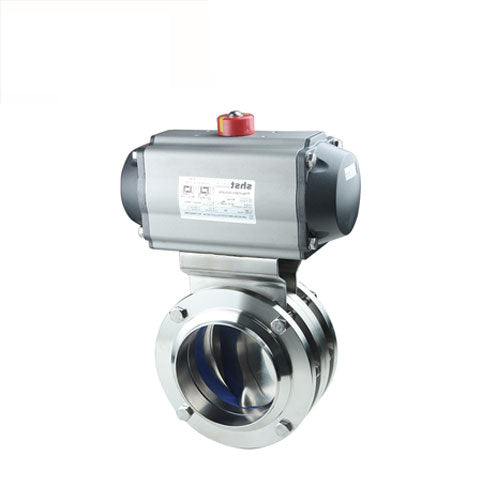In food, pharmaceutical, and biotech facilities, automating process control while maintaining sterility presents a critical challenge. Sanitary butterfly valves with pneumatic actuators solve this by combining hygienic design with reliable automation—ensuring consistent flow control without contamination risks. If you’ve faced manual valve operation errors, cleaning inefficiencies, or FDA audit failures, this guide explains how the right valve-actuator pairing elevates your system’s safety and efficiency.
Why Pair a Sanitary Butterfly Valve with Pneumatic Actuation?
Sanitary butterfly valves alone offer crevice-free flow paths and CIP/SIP compatibility. Adding a pneumatic actuator introduces:
- Automated precision: Consistent quarter-turn operation (±0.5° accuracy)
- Speed: Full open/close in 1–5 seconds (vs. 30+ seconds manually)
- Safety: Isolates operators from high-temp/pH processes
- Integration: Seamless PLC control for batch processing
Example: In vaccine filling lines, pneumatic actuation eliminates human touchpoints while ensuring sterile transfers between tanks.
Key Design Features for Hygienic Performance
1. Valve Body Essentials
- Crevice-free design: Ra ≤ 0.8 μm electropolished 316L stainless steel
- Full-bore seat: Zero obstruction; ideal for viscous media (cell cultures, syrups)
- Tri-clamp/DIN connections: Quick disassembly for cleaning/validation
2. Pneumatic Actuator Requirements
- IP69K rating: Withstands high-pressure washdowns
- Corrosion-resistant housing: Anodized aluminum or 316L stainless
- Fail-safe spring return: Closes automatically on air failure (critical for sterility)

Industry Applications & Benefits
| Industry | Use Case | Eagle Solution Advantage |
|---|---|---|
| Dairy | Yogurt culture transfer | Zero-cavity seats prevent Lactobacillus buildup |
| Biopharma | Buffer solution diversion | 100% leak-tight shutoff for GMP compliance |
| Beverage | Carbonated liquid filling | High-cycle seals withstand CO₂ permeation |
3 Critical Selection Criteria
-
Torque Matching
- Calculate required torque: Factor in fluid viscosity, pressure drop, and valve size.
- Underpowered actuators fail to seal; oversized ones damage seats.
- Eagle’s sizing tool: Matches actuator torque to valve specs automatically.
-
Cleanability Validation
- Ensure actuator stem seal is FDA-compliant (e.g., EPDM/FKM)
- Verify no lubricant migration into process media
-
Certifications
- Mandatory: 3A, EHEDG, FDA 21 CFR 177
- Industry-specific: ASME BPE (biopharma), EC1935 (food)
Eagle’s Engineering Edge: Solving Hidden Pain Points
While valves and actuators exist independently, Eagle focuses on integrated performance:
Patented Stem-Seal Interface
- Double-barrier stem seal blocks microbial ingress
- Self-aligning design prevents binding after 10,000+ cycles
Modular Actuator Design
- Tool-free spring replacement in <5 minutes
- Position indicators visible from 360°
Uncompromising Materials
- Forged 316L valve bodies (no porosity)
- ISO 8573-1 Class 3 air-ready actuators
A contract manufacturer reduced valve-related deviations by 90% using Eagle’s integrated assemblies in monoclonal antibody lines.

Maintenance Best Practices
-
Preventive Checks
- Monthly: Verify air filtration (0.1 µm)
- Quarterly: Inspect seat elasticity
-
CIP Optimization
- Orient valve 15° from horizontal for drainability
- Use 4% caustic at 80°C for biofilm removal
-
Troubleshooting
- Slow actuation: Check air supply (min. 5.5 bar)
- Seal leakage: Replace every 2 years (or 5,000 cycles)
Conclusion
A sanitary butterfly valve with pneumatic actuator is more than the sum of its parts—it’s your safeguard against contamination and human error in automated processes. By prioritizing matched torque, certified cleanability, and fail-safe reliability, you ensure product integrity while boosting efficiency.
For facilities demanding measurable hygiene outcomes, Eagle’s integrated assemblies deliver precision where it matters most: at the intersection of sterility and automation.
Need help specifying valves for your hygienic process? Eagle engineers provide application-specific torque calculations.









